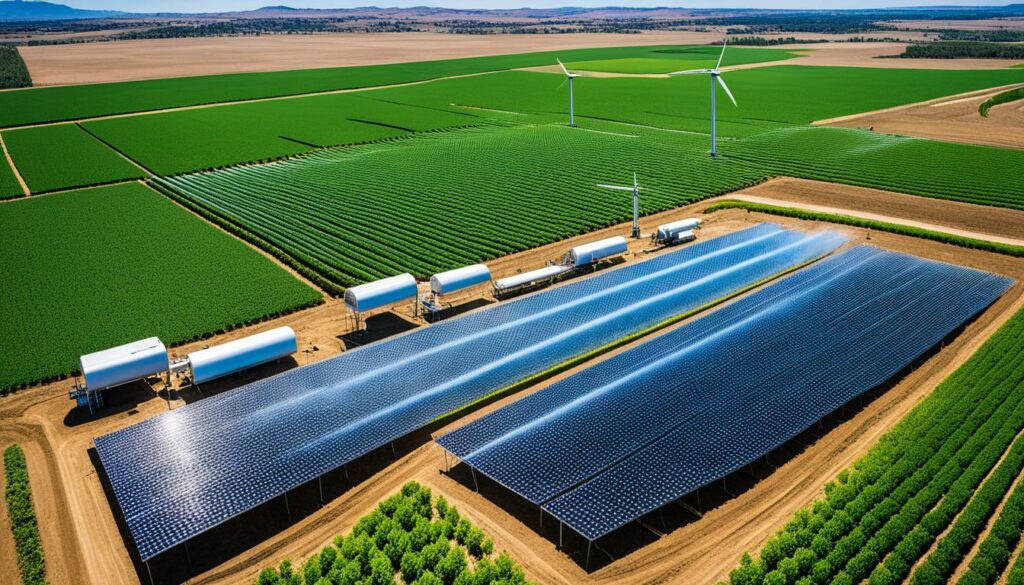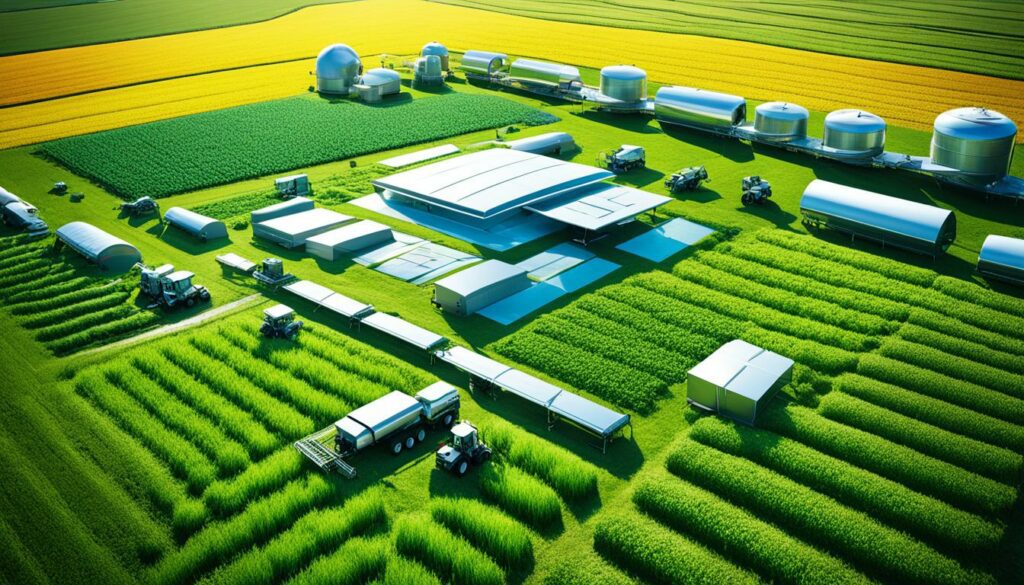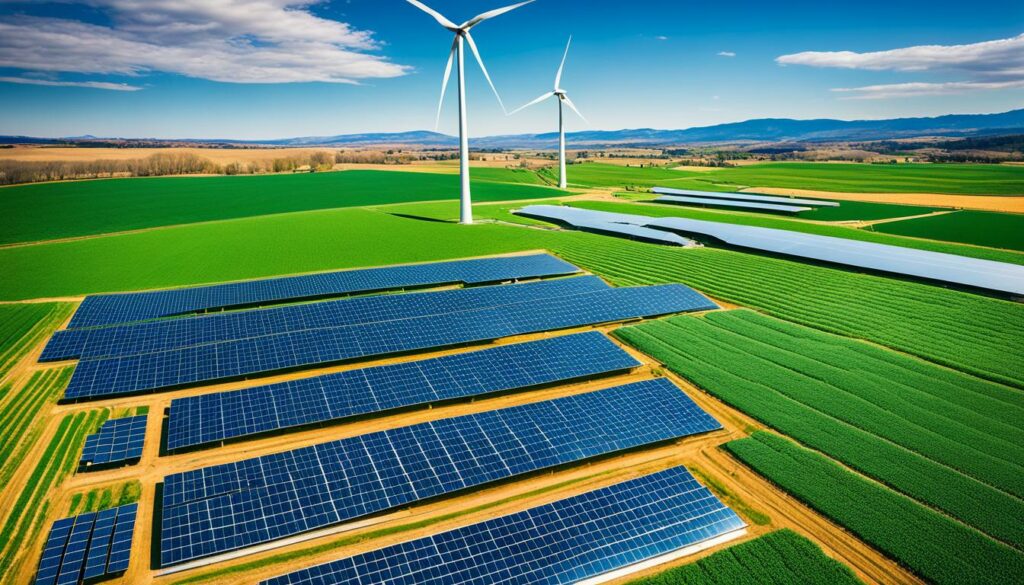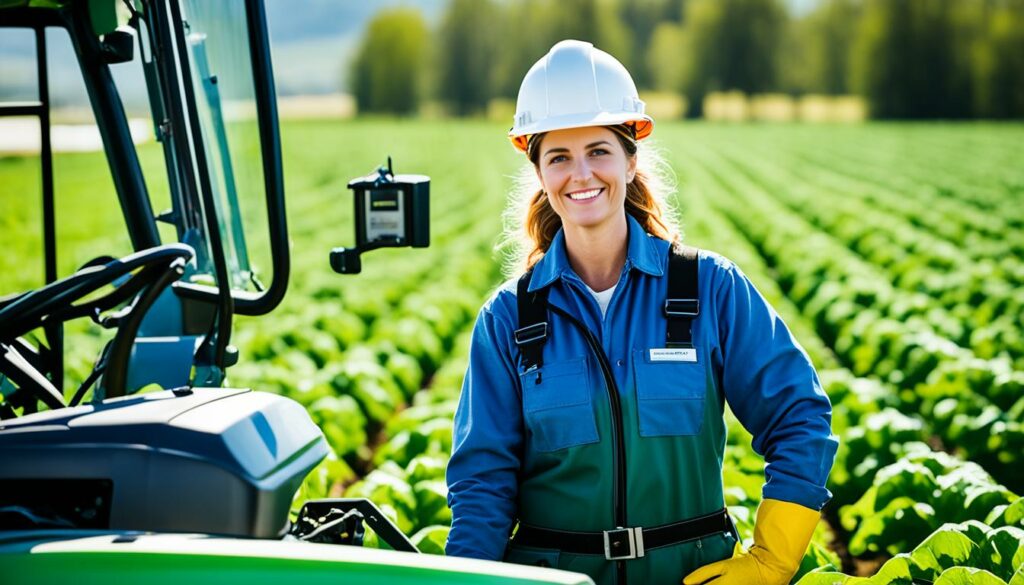Menu

Did you know that agriculture uses the most freshwater globally? It uses a massive 70% of the supply. Nowadays, with sustainability a top priority, farming has changed a lot. Now, modern farms rely heavily on technology.
Technologies like sensors, robots, and IT systems are a big help. They make farming more profitable, efficient, and safe. Importantly, they help farms follow environmental rules. This means using water, fertilisers, and pesticides better, which cuts down harm to the environment.
Modern agriculture has seen huge changes thanks to technology. It’s making farms more productive and kinder to the environment. Agricultural technology advancements help farmers run things better, from planting to harvest.
When we talk about ‘technology in agriculture’, we mean many things. This includes everything, from basic tools to high-tech systems for digital tools for sustainable farming. Now, farmers use satellite images, sensors, and IoT to boost their farms. This leads to better crops using fewer resources. It’s crucial with the expected increase in food demand by 2050.
Vertical farms are a great example of using technology to save water. They use 70% less water than regular farms. This shows how green technology solutions are key in saving important resources. Also, tech like blockchain makes it easier to track food, fight fraud, and keep it safe to eat.
The precision agriculture market is growing fast and might hit $43.4 billion by 2025. It includes AI for smarter farming decisions and robots for hands-off work. These new tools mean less waste and harm to the planet.
Technology is changing agriculture quickly. It makes farmers do better for the planet and grow more food. Agricultural technology advancements are crucial for tackling the issues agricultural faces today.
Advanced technologies in farming have changed how we grow food. They use eco-friendly methods. This helps make farming more productive, sustainable, and kind to nature.

Precise farming helps farmers use resources better. Technologies like AI check the weather and soil. This info lets farmers grow more crops. A report sees the precision agriculture market growing to $43.4 billion by 2025.
Advanced tech tackles water scarcity and lessens chemical use. Vertical farms need up to 70% less water. They show how farming’s future is less resource-hungry. Machines check soil moisture and water plants just right. Sensors and AI also help use less fertiliser and pesticides.
New tech helps the environment by cutting down chemical runoff. It also means farmers use only the needed water and chemicals. This saves natural habitats. Sensors check on crops in real time. They watch things like soil moisture and temperature. This keeps crops healthy and boosts the harvest.
“Innovative technologies in agriculture can increase efficiency and productivity, improve sustainability by reducing water usage and chemical inputs, ensure better quality control, and provide better access to markets for farmers.”—Grand View Research, Inc.
| Impact | Benefit |
|---|---|
| Higher Crop Productivity | Maximised yields with minimum inputs |
| Reduced Use of Resources | Efficient water and fertiliser usage |
| Environmental Benefits | Minimised chemical runoff |
The world of agriculture is changing a lot, thanks to new tech like agricultural robots and precision farming. These changes aim to make farming more efficient, improve the quality of crops, and help the environment.
Today, agricultural robots are vital in farming. They can do many jobs, from planting to harvesting. Their use cuts labour costs and makes farms work better. The U.S. National Science Foundation and USDA NIFA work together to create better robots for farming.
By 2050, the world’s population could be 9.7 billion. This makes precision farming very important. It uses robots, IoT sensors, and drones for smart farming. These tools gather data and help make quick decisions, making the most of resources.
Precision farming helps the agriculture sector in many ways. Thanks to data analytics, farmers can use land, water, and work better, boosting crop growth. IoT sensors check on things like moisture and soil health, giving a full picture of the field.
It also includes Artificial Intelligence (AI) and Machine Learning. These tools look through data from sensors to find trends and issues. This means they can adjust things, like better fertiliser use, to fit the need for careful environmental care.
Robots do jobs like seeding and weeding, making things faster and less wasteful. This is good for the planet. Advancements in robotics aim to grow more food while being gentle on the environment.
The investment in robotics by NSF and USDA NIFA aims to improve agriculture. They work together for more sustainable and advanced farming. This is important for a growing global population and for protecting the environment.
By 2050, farmers need to produce 70% more food than in 2009 to feed over 10 billion. Digital tools in farming are crucial for this. They use technologies like GPS in agriculture, sensors for checking temperature and moisture, and aerial images. These tools change how we do farming, making it more efficient and better for the planet.
GPS technology in agriculture has changed how fields are managed and resources used. It gives accurate maps and guides for machinery. This means farmers can use things like fertilisers and water better. They waste less, making their work more productive and friendlier to the environment.
Sensors that measure temperature and moisture are key for today’s farmers. These sensors for farming give instant information about the soil, like how wet it is. By keeping an eye on these details, farmers can improve when they water and how they put down fertiliser. This can cut down water use by 15-30% and lower costs by about 15%. It also helps crops grow better, increasing their yield by 15-20%.
Drone technology in agriculture is vital for aerial views. With special cameras, drones spot things like plant diseases or not enough water. Catching these problems early means farmers can act quickly to save their crops. Drones also help check large areas faster and are doing 30% of all crop spraying in South Korea.

In summary, combining GPS in agriculture, sensors for farming, and drone technology in agriculture helps farming be more sustainable. These tools let farmers use resources better, keep their crops healthy, and help feed more people by 2050.
| Digital Tool | Function | Benefits |
|---|---|---|
| GPS Technology | Field mapping and machinery guidance | Optimization of resource application, reduced waste |
| Temperature and Moisture Sensors | Real-time soil condition monitoring | Reduced water consumption, increased yield |
| Aerial Imaging (Drones) | Detection of crop stress and disease | Timely interventions, enhanced crop health |
Eco-friendly agricultural innovations help move towards sustainable farming. In the U.S., sustainable farming uses methods to meet food needs, protect the environment, and use resources better. This way, farms can support their economy, farmers’ lives, and help society.
Integrated Pest Management (IPM) is a key innovation. It uses different ways to control pests, keeping crops safe without harming nature. Also, moving animals in rotational grazing helps reduce feed costs and keeps fields from getting too much manure.
To keep the earth healthy, farmers also employ methods like strip cropping. This and other soil conservation ways protect against soil erosion, ensuring farms can keep growing food. Ways to save water are also vital, like planting strips of trees near water, which keep water clean and protect wetlands.
Having many different crops helps farmers deal with changes in weather and markets. It also helps keep the soil and nature healthy, attracting helpful insects and providing homes for wildlife. Managing nutrients well is also key, through careful use of manure and nitrogen, for healthy soil and water.
Agroforestry is about using trees on farms, which is good for both the land and the environment. Trees help keep the farm ecosystem balanced. Selling food directly at markets, online, or through special community programs also makes farming more profitable.
Here is a look at how different farming practices help the environment and make money:
| Practice | Primary Benefit | Environmental Impact |
|---|---|---|
| Integrated Pest Management (IPM) | Minimises risks | Reduces chemical use |
| Rotational Grazing | Reduces feed costs | Prevents overgrazing |
| Soil Conservation | Prevents erosion | Maintains soil health |
| Water Conservation | Maintains water quality | Protects wetlands |
| Crop Diversity | Risk reduction | Enhances biodiversity |
| Nutrient Management | Improves soil quality | Protects the environment |
| Agroforestry | Integrates tree usage | Improves ecological balance |
| Alternative Marketing | Enhances profits | Supports local economies |
Green technologies are must-haves for farmers working under strict environmental rules. They help in meeting high standards without harming nature. The Green Technology and Sustainability Market was already worth US$14.28 billion in 2022. It is estimated to keep growing at 12% from 2023 to 2030. Investing in these solutions clearly brings many good things.

CropX Inc. and Hortau Inc. shine in using green tech in farming. With about 50 employees in 15 countries, CropX and about 100 employees internationally, Hortau use sensors and IoT for smart farming. This makes sure resources like water are used right. Also, it helps to follow environmental rules well.
Tools like remote monitoring and quick alerts are key for keeping up with green rules. They help companies see their eco impacts live, needed for staying compliant. Enablon France SA, with over 500 workers in 160 countries, uses such apps for its green tech efforts.
Use of various green tech can make farming more efficient. Adding sensors, IoT, and advanced software helps in smarter farming. It lets companies make better choices and look after nature. Tools for showing data play a big role here, helping in reports and setting plans.
Big names like General Electric (GE) show the wide scope of green tech in farming. GE works in over 180 countries with more than 200,000 staff. This shows how much green tech can do, even for huge operations. Tech Mahindra Limited, with 125,700 employees in 90 countries, also shows the benefits at this scale.
Using green tech and sticking to eco rules lead to farming that’s good for the planet. It’s a complete tech-driven method that helps reduce bad effects on nature. Plus, it saves resources, keeping our world healthy for a long time. With more innovation and research, the farm of the future will be greener and more promising.
The fine line between using tech in farming and keeping the environment safe matters a lot. It makes sure farming is not only eco-friendly but also meets the rules. The Environmental Protection Agency (EPA) takes a lead in setting these rules, which some farmers find burdensome. Yet, following them is key to keep farming going without harming the earth.
Agricultural practices, mainly, aren’t directly controlled by national eco laws. Only big farms like CAFOs must follow special permits rule. This means, farming rules need to focus on its unique impact on the environment. Shifts like making more biofuels, such as E15 gasoline from corn, are big parts of the greener energy plan.
| Regulatory Area | Agency | Key Focus |
|---|---|---|
| Air and Water Quality | EPA | Emission controls and water quality standards |
| Pesticides | EPA | Registering and restricting use due to health and environmental risks |
| Bioenergy Production | Federal Energy Policy | Ethanol production under the Renewable Fuel Standard (RFS) |
The FPAC Business Centre’s ENV helps government farming agencies like FSA and NRCS understand eco rules. They make sure farming projects, under these laws, are good for the environment. This includes respecting laws like the Clean Water Act and Clean Air Act.
The NRCS and FSA back up eco-steps through checking how farming plans affect nature and by teaching the public about these eco steps. Workers in local offices make sure environmental rules are followed correctly. This happens at all levels, from local to national.
Regs have changed a lot, from early water pollutions rules to today’s laws safeguarding the air and water. The modern eco rules also look after endangered species and handle harmful waste. This shows how varied and needed the eco rules for farming tech are.
In wrap-up, tech in farming has to follow eco rules for a green future. By following strict eco standards, farmers make both the planet and their farms healthier. They keep the agricultural life in balance with the natural world.
Advancements in agricultural technology have made a big difference in agricultural worker safety. It has made working on farms much safer for the people. Thanks to things like robotics and drones, many dangerous jobs don’t need people anymore. This has reduced the chance of accidents and injuries a lot.
Farm automation is changing how things work a lot. Devices like autonomous tractors and robotic harvesters are making farming safer. They keep workers away from risky machines. This change shows how technology benefits in farming. It makes farming more efficient and keeps workers well.

Now, precision agriculture is also playing its part in worker safety. It helps reduce a farm worker’s direct contact with harmful chemicals. Tools for precise handling of fertilisers and pesticides keep workers safer. This precision also helps the environment by saving resources and reducing harm.
Adding to this, automated monitoring is improving agricultural worker safety. Sensors and analysis by AI find and fix dangers fast. This makes the working conditions much safer. It also keeps an eye on plant health and fields, reducing risks and making farms operate better.
Advance in livestock tech is also making a difference. It’s not just about being more productive. It’s also caring better for animals and making managing them easier. This leads to safer ways of working for people. They face less risk and work more efficiently.
In the end, tech in agriculture is boosting productivity and looking after the planet. It’s also making work much safer for those on the farm. With automation, precise tools, and careful monitoring, farms are becoming safer places for all workers. This is good for everyone involved in farming.
Governments play a big part in making agricultural tech better. They create strong policies and offer help. This helps in making new things and keeping our food safe. It takes a team effort and careful planning to make sure these changes help everyone.
Important policies come from the government to support farm tech. The 2018 Farm Bill is one example, it gives money for new ideas. Programs like the NIFA’s AFRI help with things like making farming greener and animals healthier.
“Precision agriculture techniques, such as automated planting and harvesting, enhance agricultural efficiency and sustainability”
Joining other countries in technology shows we’re still ahead. This helps farmers grow more food while protecting the earth. It also serves other important goals, like making sure everyone has enough to eat.
One main goal of farm policies is to make sure we have enough safe food. Governments help by investing in finding and fixing food problems before they spread. Things like using blockchain help check food is real and not harmful. Also, new ways of farming, like vertical farming, can produce food all year.
New tech, like drones for spotting sick plants, helps to use money better without cutting quality. Governments backing these advances make sure we can feed the world. This shows how important the government role in agri-tech is for keeping food safe and plenty for all.
Technology has changed farming a lot. But, following environmental rules isn’t easy. It’s hard because the new tools are really expensive. This makes it tough for many farmers, especially in rural places, to keep up.

Rules like the Clean Air Act (CAA) and Clean Water Act (CWA) are strict. They mean farmers have to spend a lot on new tech and know-how. But not everyone can afford this. That’s why some farms find it hard to use the newest tech.
A big problem is water pollution caused by farm water waste. It affects many rivers. Even with new ways to reduce waste, it’s hard to do this everywhere. Also, a lot of farm soil is washing away, making things even worse.
Some old ways of farming are hard to change, even when they help the environment. Laws like the Resource Conservation and Recovery Act (RCRA) try to fix this. But figuring out how to make everyone follow the rules is tough.
Using more data sounds like a good idea. Places like Colorado are trying it out to do better and spend less. But, it’s not always easy for everyone to use. Maybe giving more help with the tech could make things better. Yet, we don’t have enough proof that this works well.
| Regulation | Year Enacted | Goal |
|---|---|---|
| Clean Air Act (CAA) | 1963 | Regulate air emissions |
| Clean Water Act (CWA) | 1948 | Regulate pollutant discharges into water |
| Resource Conservation and Recovery Act (RCRA) | 1976 | Governs solid and hazardous waste disposal |
| Endangered Species Act (ESA) | 1973 | Protect critically endangered species |
The field of sustainable agriculture technology is swiftly evolving. This change shows a bright future for farming. We need to grow more food to meet the world’s needs.
New tech in farming like autonomous tractors and drones are here. These advancements help produce more food with less harm to the earth. The market for these inventions is set to reach $43.4 billion by 2025, showing their importance.
Staying innovative is key to farming’s future challenges. Technologies like blockchain and AI are being used to make food safer and more sustainable. With more people to feed, we need to find better ways to farm.
| Trend | Impact |
|---|---|
| Precision Agriculture | Improved resource efficiency and higher crop quality |
| Blockchain Technology | Enhanced food traceability and supply chain transparency |
| Vertical Farming | Significant reduction in water use and land footprint |
| Artificial Intelligence | Advanced monitoring of plant health and soil conditions |
Agriculture is changing fast, with technology at its core these days. This shift is crucial for farmers to meet green standards. They need to know all about the rules. The Environmental Protection Agency oversees this with acts such as the Clean Water Act. These ensure water pollutants are controlled.
Other rules, like the Federal Insecticide, Fungicide, and Rodenticide Act, deal with pesticide use. They make sure these chemicals don’t harm nature too much. For those dealing with waste, the Resource Conservation and Recovery Act sets the path, guiding from creation to disposal.
With the importance of eco-friendly farming growing, understanding rules is key. These laws push for using tech to protect the environment. They are not just about following rules but also about taking care of our planet for the future.
The USDA has its own set of important rules too. These include telling consumers if their food is bioengineered, as well as ensuring organic products are truly organic. Focusing on health, the Food Quality Protection Act tracks pesticide residues. It aims to make sure food is safe to eat. And the Perishable Agriculture Commodities Act looks out for businesses selling fresh food.
For the air we breathe, the Clean Air Act steps in. It aims to reduce air pollution from farms. All these rules are a must for sustainable farming. To learn more about these important rules, visit Compliance 101 in Agriculture.
Technology has greatly increased crop output. This is through precision farming. Farmers can now use resources better and get bigger harvests. Tools like sensors and GPS allow for smart use of water, fertiliser, and pesticides.
Robotic tech makes farming more efficient and cuts down on work costs. Robots do jobs like planting and checking on crop health. This boosts how much we get from farms and uses less hard graft, saving money and increasing the win.
Digital tools, including GPS and sensors, back up eco-friendly farming. They give farmers detailed info that helps them manage fields better. This means less waste and more green farming methods.
Think about organic farming and using friendly bugs to control pests. Also, farmers are turning to things that break down naturally. These ideas help the planet by keeping harmful farming to a minimum and following important green rules.
Green tech cuts down on farm pollution and manages natural resources wisely. By using clean energy and smart irrigation, farmers do better at protecting the environment. These things also meet the rules for good farm practices.
Rules on protecting nature push farmers to use tech that is good for the environment. These rules help make sure farming is kind to the earth. They make sure we take care of our planet, following what the law says.
High-tech farming keeps workers safer by taking on risky jobs. Machines that work by themselves mean less danger for people on the farm. This makes the job safer for everyone who works the land.
Governments work to make farming tech better through laws and money for research. They aim to keep food coming and help farms succeed in the long run. This is by spurring new ideas and supporting the industry.
Meeting environmental rules with tech faces issues like cost and getting the right tools. Farmers need to learn and get help to switch to cleaner ways of farming. To fix these, we need to invest, teach, and back our farmers up.
The future of farming tech is likely high-tech devices for better, greener farms. We need to keep researching to feed the world in a way that’s kind to the earth. This calls for always finding new and better ways to farm.
In farming, tech and following green rules are tied together as tech finds answers for more planet-friendly farming. By using advanced tools, farmers can be better for the environment and work more efficiently.